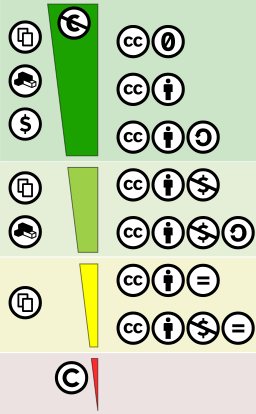We’ve covered copyright on this blog before. Since that time we’ve developed a guide to copyright that has a permanent home on our Cite Sources guide.
The guide is intended not to be comprehensive but to answer the most common copyright questions we’ve received over the years. Also, just a disclaimer that the guide is not legal advice and any complex copyright issues should be brought to the attention of the College’s General Counsel.
A common question we get is “can I use X in class?” X is any material of known or unknown copyright. When I’m asked copyright questions I always start with a few questions of my own: Who owns the copyright? What is the intended use (in-person or online instruction)? The answers determine how to proceed.
If the material is in print and the intended use is for face-to-face instruction, I refer you to Reproduction of Copyrighted Works by Educators and Librarians, Circular 21 by U.S. Copyright Office. This document outlines reproduction of copyright works by educators primarily for in-person instruction.
If you have questions about what can be reproduced in an online environment like Canvas, see the center box of the Copyright guide for a summarized list of best practices.
Obtaining permission is a big part of copyright best practice. If you want to share or reproduce a work under copyright protection in an online class it is advisable to seek written permission from the copyright holder. Start early and write to the copyright holder. The Columbia University Libraries Asking for Permission site has sample letters to help you draft your own permission-seeking letter. If you receive word back from the copyright holder granting permission be sure to keep that letter on file for the duration of use. You will need to repeat the process for each subsequent semester you use the material. What if you cannot find the copyright holder? Search for the material in question in the Copyright Clearance Center Get Permissions tool. Note that you may have to pay for a license. If you have questions or difficulty identifying the copyright holder, ask a librarian for assistance.
What if the material is Open Access, Public Domain or has a Creative Commons license? Each of these are slightly different. See definitions on the guide in the Copyright Terminology box. Of these, Creative Commons is the only one that may have restrictions on use and sharing. You do not need to contact the copyright holder of a work under Creative Commons license as long as the license allows sharing/reuse. Follow the instructions of a Creative Commons license and always attribute the creator. For specifics of the different Creative Commons licenses and what each allows see About The Licenses. The image below summarizes how Creative Commons license symbols can be combined to grant various share/reuse rights.
Creative Commons license symbols by Shaddim; original CC license symbols by Creative Commons - https://creativecommons.org/about/downloads/ https://creativecommons.org/policies/Original CC license icons licensed under CC BY 4.0, CC BY 4.0, https://commons.wikimedia.org/w/index.php?curid=47247325
Can films and videos be shared in Canvas? Film and video have their own copyright restrictions. The restrictions differ depending on in-person or online instruction. In online environments, you are limited to showing short clips of 10% or 3 minutes whichever is less unless you have permission from the rights holder to show more. If you need to use a video from YouTube or another streaming service, check if the video has a Creative Commons License or in Public Domain. This information is usually in the information section below or next to a video. If the video you want to use does not have a reuse/share license you might need to find an alternative or pay for a license through a company like Swank. There are more suggestions for finding streaming video on the guide.
What about Fair Use? It does apply in specific cases, however it is important to remember that Fair Use is a defense and not a rule. Whenever you come up with a copyright question that could be covered under Fair Use, think through the problem using the ALA Fair Use Evaluator. Keep the outcome of your analysis on file in case your use is challenged. You can also read more about Fair Use from Center for Media and Social Impact. They have a comprehensive list of Best Practices regarding Fair Use broken down by media type and setting.
I hope you will check out the new copyright guide. As always, if you have any questions about copyright please reach out to the library.
Reference and Special Collections Librarian 610-526-6022 |


